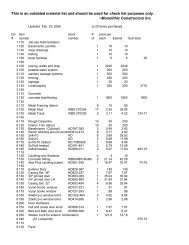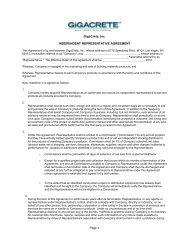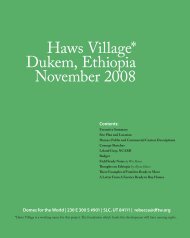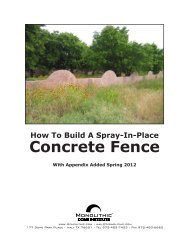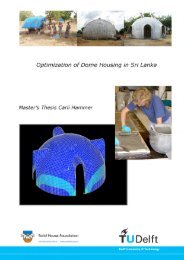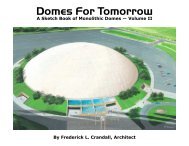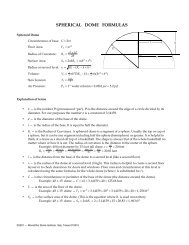Literature Review on Building Envelope, Heating and ... - Beeshive.org
Literature Review on Building Envelope, Heating and ... - Beeshive.org
Literature Review on Building Envelope, Heating and ... - Beeshive.org
Create successful ePaper yourself
Turn your PDF publications into a flip-book with our unique Google optimized e-Paper software.
of Alaska museum where RH was 45%. Adkins suggested 30% RH in buildings in<br />
Fairbanks was reas<strong>on</strong>able <strong>and</strong> achievable in residential buildings. In commercial<br />
buildings, 30% RH could be achieved by separating the c<strong>on</strong>structi<strong>on</strong> process of the<br />
vapour <strong>and</strong> insulati<strong>on</strong> from interference by the structure, electrical, mechanical, <strong>and</strong><br />
finish materials.<br />
Moisture C<strong>on</strong>trol: Northern Regi<strong>on</strong>s<br />
Three types of barriers are needed in building envelopes in the north (CMHC, 1994-1):<br />
• a wind or weather barrier <strong>on</strong> the outside of the envelope to protect the envelope from<br />
blowing snow <strong>and</strong> rain;<br />
• an air barrier system to prevent exfiltrati<strong>on</strong> of indoor air through the envelope; <strong>and</strong><br />
• a vapour barrier, <strong>on</strong> the warm side of the envelope, to prevent water vapour from<br />
entering the envelope.<br />
One material may serve as an air <strong>and</strong> vapour barrier provided it is located <strong>on</strong> the warm<br />
side of the envelope.<br />
Impact of Improper Selecti<strong>on</strong> <strong>and</strong> Placement of the Vapour Barrier, Arctic<br />
Carls<strong>on</strong> (1996) dem<strong>on</strong>strated how improper selecti<strong>on</strong> <strong>and</strong> placement of the insulati<strong>on</strong>, the<br />
vapour barrier, <strong>and</strong> the lack of venting of wall assemblies could lead to building envelope<br />
deteriorati<strong>on</strong> due to c<strong>on</strong>densati<strong>on</strong> that usually becomes apparent five to ten years later.<br />
Moisture diffusi<strong>on</strong> through the inner layer of the building envelope might c<strong>on</strong>dense near<br />
impermeable outer layers <strong>and</strong> freeze as the temperature drops below the dew point <strong>and</strong><br />
freezing. Moisture accumulati<strong>on</strong> <strong>and</strong> frost buildup will be much greater in northern<br />
climates, such as Alaska <strong>and</strong> Minnesota.<br />
The examples included a retrofit of an impermeable exterior insulated <strong>and</strong> finish system<br />
(EIFS), which was applied <strong>on</strong> the exterior of an insulated wall in a building in Fairbanks,<br />
Alaska. A polyethylene vapour barrier was placed <strong>on</strong> the warm side next to the interior<br />
gypsum board, but because of imperfecti<strong>on</strong>s, water vapour diffused into the wall,<br />
c<strong>on</strong>densed, <strong>and</strong> froze near the inner face of the EIFS panel. As a result, the panel’s<br />
fasteners corroded <strong>and</strong> the frost buildup caused some panels to protrude from the wall.<br />
Carls<strong>on</strong> attributed this damage to a lack of venting of the EIFS panels. Venting would<br />
allow excess moisture to drain or evaporate.<br />
Carls<strong>on</strong> (1996) also presented a spreadsheet tool to assist designers <strong>and</strong> builders in the<br />
selecti<strong>on</strong> <strong>and</strong> placement of the vapour barrier, insulati<strong>on</strong>, <strong>and</strong> venting in the building<br />
envelope assembly. The spreadsheet calculates dew point temperatures in insulated<br />
building envelope assemblies. As an example, Carls<strong>on</strong> used the spreadsheet to investigate<br />
moisture deteriorati<strong>on</strong> of a Fairbanks, Alaska, building. Carls<strong>on</strong> made the following<br />
recommendati<strong>on</strong>s.<br />
• A dew point analysis should be c<strong>on</strong>ducted for each building envelope assembly based<br />
<strong>on</strong> local climate c<strong>on</strong>diti<strong>on</strong>s. The calculati<strong>on</strong>s are particularly important for EIFS <strong>and</strong><br />
other insulated assemblies retrofitted over insulated steel or wood framing.<br />
PERD-079: Task 2 - <str<strong>on</strong>g>Literature</str<strong>on</strong>g> <str<strong>on</strong>g>Review</str<strong>on</strong>g> 5



